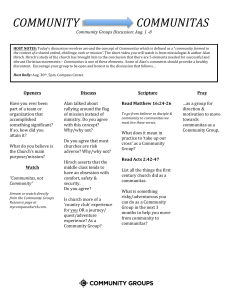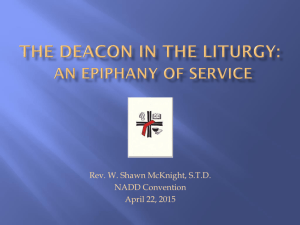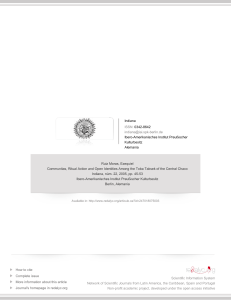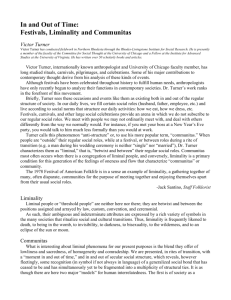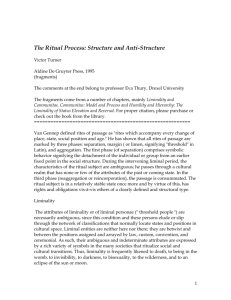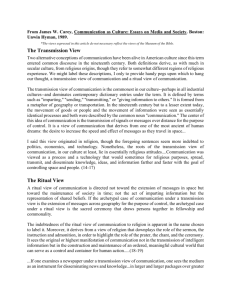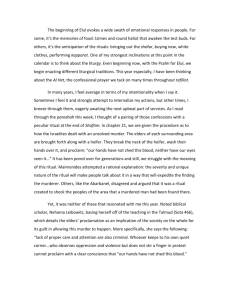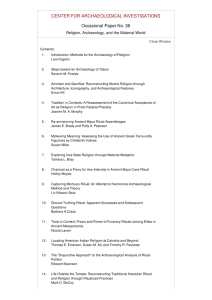Communitas, Ritual Action and Open Identities Among the Toba
advertisement
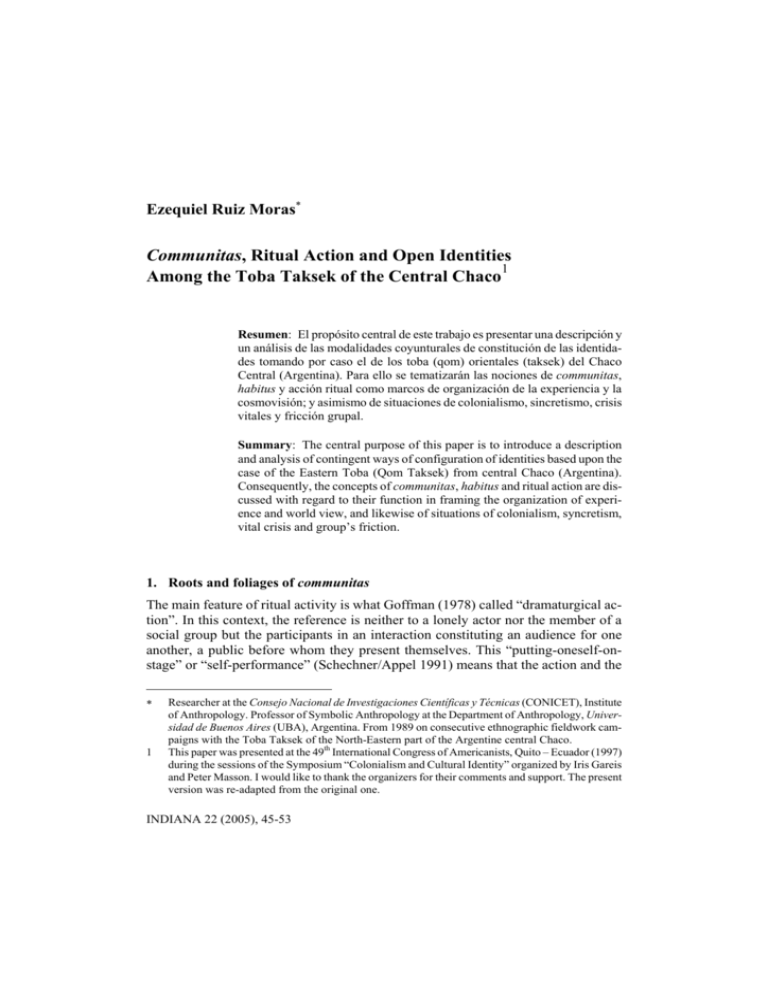
Ezequiel Ruiz Moras∗ Communitas, Ritual Action and Open Identities 1 Among the Toba Taksek of the Central Chaco Resumen: El propósito central de este trabajo es presentar una descripción y un análisis de las modalidades coyunturales de constitución de las identidades tomando por caso el de los toba (qom) orientales (taksek) del Chaco Central (Argentina). Para ello se tematizarán las nociones de communitas, habitus y acción ritual como marcos de organización de la experiencia y la cosmovisión; y asimismo de situaciones de colonialismo, sincretismo, crisis vitales y fricción grupal. Summary: The central purpose of this paper is to introduce a description and analysis of contingent ways of configuration of identities based upon the case of the Eastern Toba (Qom Taksek) from central Chaco (Argentina). Consequently, the concepts of communitas, habitus and ritual action are discussed with regard to their function in framing the organization of experience and world view, and likewise of situations of colonialism, syncretism, vital crisis and group’s friction. 1. Roots and foliages of communitas The main feature of ritual activity is what Goffman (1978) called “dramaturgical action”. In this context, the reference is neither to a lonely actor nor the member of a social group but the participants in an interaction constituting an audience for one another, a public before whom they present themselves. This “putting-oneself-onstage” or “self-performance” (Schechner/Appel 1991) means that the action and the ∗ 1 Researcher at the Consejo Nacional de Investigaciones Científicas y Técnicas (CONICET), Institute of Anthropology. Professor of Symbolic Anthropology at the Department of Anthropology, Universidad de Buenos Aires (UBA), Argentina. From 1989 on consecutive ethnographic fieldwork campaigns with the Toba Taksek of the North-Eastern part of the Argentine central Chaco. This paper was presented at the 49th International Congress of Americanists, Quito – Ecuador (1997) during the sessions of the Symposium “Colonialism and Cultural Identity” organized by Iris Gareis and Peter Masson. I would like to thank the organizers for their comments and support. The present version was re-adapted from the original one. INDIANA 22 (2005), 45-53 Ezequiel Ruiz Moras 46 subjectivity of the participants does not only dissociate at a certain moment of the group but the reference to the world also varies from habitual ways. To start, we are presented with two co-implied questions: First, which are the aspects of the relation between the dramaturgical-ritual actions, the ways of configuration of identities (selfness/otherness) of the group and the aspects of social structure? And secondly, which modalities does this relation assume in rituals of shamanic initiation and in curative rituals practiced by the Toba Taksek2 of the Chaco Central? Assuming that dramaturgical actions are symbolic manifestations framed in a ritual process as “self-performance”, it will be commonplace to refer to the teleological and strategic dimension of ritual action. Habermas (1989: 236) in an attempt to expand and overcome the teleological-strategic dichotomy suggested an analysis of the basic types of social action identifying: a) b) c) d) e) The notion of teleological action, in which “the actor accomplishes an end or produces the wished state of affairs”3 choosing in a certain situation the most “consistent” means and using them in the correct way. Strategic action, in which “the actor chooses and calculates means and ends” from the point of view of maximization and expectations of usefulness. Action ruled by principles, in which “the behaviour of the members of a social group leads their actions through common values”. Dramaturgical action, in which “self-performance does not imply a spontaneous expressive behaviour but an aesthetic expression of one’s personal experiences” built taking in mind the spectators. Communicative action, in which “the relations between an actor and the world are expressed through linguistic means”. From this perspective, different ways or logics of the action participate in different ways of the general notion of “social action”. Going back to the notion of communitas that Turner (1974; 1980; 1988), following the philosopher Buber (1972), identified as the essential modality of social relations, the ontological and intersubjective link I-Thou, rather than the commonplace socialstructural link (social status, ancestry and filiation regimes, location rules, assigned status, acquired status, etc.): The emphasis Turner lays on the notion of communitas intends to highlight, in the context of ritual action, the dialectics between the structural and the anti-structural dimension (represented in the rites de passage by the liminal personae). 2 3 The Toba, who call themselves Qom (people), belong to the Guaycurú linguistic family and live in the Chaco plain in northeastern Argentina. Traditionally they were organized in bilateral nomad bands of extended families. They migrated throughout a defined hunting territory, gathering together at certain times of the year for trading, marriage agreements, and ritual activities. The basic social unit was the extended family, a group of relatives who cooperated and shared resources without a system of central authority. All the translations from Spanish texts are by the author (E. R. M.). Communitas, Ritual Action and Open Identities 47 Nevertheless, the typical Turnerian classification of communitas into existential or spontaneous, normative and ideological would rather refer to an ontological, epistemic and normative dimension. By ontological dimension of the communitas I mean the referential ways in which this link is represented among an I, a Thou and the World and, by normative dimension, the prescriptions, strategies and specific ideologies practiced at a certain moment in the history of a group. Although these three dimensions of the communitas imply one another, the ontological dimension stays in the background as far as the typical link between the epistemic and the normative is concerned and even in the last dimension, which, as explanatory key, attempted to reflect the other two. So, within the ritual process, it is possible to single out, an oscillation between, on one hand the relation among the beings and on the other, the relation among social people. Both groups establish ways of relating to the world according to the contexts in which their performances make sense and are legitimate. There’s no categorical distinction between these three dimensions. They rather co-participate as a joint, in everyday life. In highly significant contexts such as rituals, the modalities assumed by each dimension turn dynamic and complex. The communitas is dynamic as well as critical; that is, it is subject rather to a recurrent instable condition than to an everlasting (emotional, taxonomic, political) stable condition. This critical modality of the communitas was clearly developed by Douglas (1973) in her analysis of the Levitical abominations as well as by Turner (1980) in his analysis of the liminal period in the tree mudyi rite of passage of the Ndembu in Zambia. The phase of separation, liminality and re-aggregation typical of rites of passage (van Gennep 1979: 25), establishes then, a dialectics whose extremes are, on one hand, the communitas and, on the other, the structure. The liminal phase of initiation rites, precisely, as an “in between” jeopardizes the ontologic, the epistemic and the normative/ideologic. This in-between the being and non-being, the knowing or non-knowing what and who one is and, which place or status an individual has in society reflects how notably traumatic the communitas is. The dialectic process by which people pass from stability to instability and viceversa, is not merely mechanic but precisely dynamic; people pass from structure to communitas to go back to a enlivened structure by the experience of the communitas. This critical dialectics rests, according to Turner, on the existence of a generic link among men as well as a related feeling of fraternity, which is not a determined epiphenomenon of a gregarious instinct but a product of devout men. Liminality, marginality and structural inferiority are conditions that often generate myths, symbols, rituals, philosophic systems and works of art. As Turner points out 48 Ezequiel Ruiz Moras these cultural ways provide men with a series of patterns or models that constitute, at a certain level, periodic classifications of reality and relation between the man and society, nature and culture, but they are also more than mere classifications, since they urge men to action as well as reflection (1988: 134). Each of these works has a multivocal and polysemic character, with multiple meanings, and is capable of influencing people at many levels. Thus, identity building is connected to a process of critical constitution in constant change rather than to a consolidation or adaptation to a certain model. This process assumes the form of trauma and social drama, precisely because in the ritual context what is at stake is the supposed certainty of the status quo. Applying this notion to semi-nomadic hunting and gathering societies, like the Taksek, we can have an insight into the dynamics of the communitas and the modalities of its critical aspect in its close relation with the ways in which identity is built. The dynamics of the communitas can be better appreciated in shamanic initiation rites or in curative rituals, that constitute highly significant contexts for the Taksek as well as privileged areas where the communitas is expressed in its triadic dimensionality. With regard to shamanic initiation rites, the acquisition of power entails a gradual and traumatic work of appropriation. The possibility to access to the shamanic condition is revealed in a dream-vision /ichoGonaGak – loGok/ or an occasional encounter of the chosen one with a spirit /itaGaiaGawa/ (usually during a raid in the woods /hawiaql’ek/) or through the incorporation or assimilation of power /halojk – l’anaGak– napiishik/ from a third party (father, uncle or grandfather) generally through saliva or objects thought to be powerful /añaGaik –wo’o da n’achek/. In the first case, the spirit chooses a person and suggests the donation of certain kind of powers /añaGaik itawa/. The person, in turn, has two alternatives; rejecting the offer or assuming the responsibility of his choice and the resulting reception of power. If he chooses the second alternative, he will have to undergo tests and hold meetings with his assistant spirit, ranging from fasts and organic purifications, sexual abstinence, learning the marks and signs of the spirit to proving the consubstantiation of the power delivered in the final test of the /nawe epaq/ or tree of shamanic initiation. This test /nawe/ consists in the initiate proving to the spirits and the others if he is able of going through the different stages of the test, which, besides, has two extreme possible results; success or failure. Success implies the consolidation of the shaman’s health and life /chalataGak/ in general while failure leads to health problems and even entails the possibility of physical disappearance /laataGak/. The reaffirmation of the shamanic condition /erapeGe/ enables the person to oscillate between the world of known human beings /jaqaja/ (relatives, allies, strangers/ordinary reality) and the world of the non-human beings /jaqa’a/ (extraordinary reality). So, there is a double link between the liminal period, typical of the state of progressive power appropriation, and the alternating condition of personae liminoide as an ontological attribute. Communitas, Ritual Action and Open Identities 49 Consequently, the modalities of the communitas can be described in terms of the above mentioned dimensions: a) Ontological dimension: The oscillation between the being and the non-being, during the period of initiation itself, is based on a fragile equilibrium bound to instability (acceptance or rejection of the power donation trauma, existential drama due to the success or failure in the appropriation and exhibition of power, possibility of life or death; everlasting drama of the liminoid condition). Being, power and increasing/decreasing power to enliven the being, constitutes the fragile ontological dynamics of the shaman. b) Epistemic dimension: The drama of the ontological consubstantiation implies working in the knowledge of the objects of the world; and this world is the one constituted by well-known human beings and powerful entities or spirits. Knowing the signs and marks of the world, as the shaman does, implies understanding the language of alterity. Consequently, the shamanic epistemic scaffolding, built in the trauma and the suffering of the liminoid condition, revitalizes, due to its inherent dynamics, the group’s conceptions of the world in terms of generation/updating of “open identities”, that is, heterogeneous configurations of experience-in-the-world. c) Normative/ideologic dimension: The process of disintegration, dissolution, differentiation and social re-installation, typical of initiation rituals, implies a necessary revitalization of the normative structure and the ideological formulations. Therefore, the context of ritual action makes the status system more dynamic, including the local mechanisms of alliances and leadership, as well as secular and political ideologies. 2. Inward the shamanistic habitus In this sense, the individual’s and/or group’s eventual moods of constitution of identities are shaped in and through the joining of the three dimensions referred to above, precisely because it is in its own dynamics where the germ of its legitimating ways lies. Communitas and identity are conjunctive; they need the reciprocal assistance of their aspects to legitimate each other. We could now introduce the notion of habitus in the sense Bourdieu (1991) uses it, that is, as a “set” of dispositions that make certain people act and react in certain ways, highlighting that these dispositions generate practices, perceptions and attitudes not necessarily coordinated or governed by any rules. In this case, the Taksek build their own habitus (especially in historical colonialisms, everyday neo-colonialisms and syncretic situations or exo-groups hostilities) according to their frail, weak and dynamic behaviour in their ritual and symbolic practices. In this sense, the structural dispositions are functional of the recurrent modalities but contingent of the communitas. This oscillation between communitas and structure enables Taksek to keep their social body undivided since they avoid a fortuitous unbalance or predominance of one over the other, precisely in the habitus. Clastres (1981) realized this when he analyzed the question of the aforementioned political power among the societies of the “Gran Chaco area”: 50 Ezequiel Ruiz Moras The leadership in a primitive society is nothing but the supposed/assumed place of power. What is the real place? The own social building that detains power as an undivided unity. This power not isolated from society is detained in just one direction, encourages only one purpose: keeping the social being undivided and preventing inequality from dividing society (Clastres 1981: 116). With regard to curative rituals, the habitus is basically performative. That is why the healing process is communitas made performance. The Taksek shamans /pi’ioGonaq/ are completely aware that the act of healing is just one step in the “disease treatment” /nlewaGaki/ and, perhaps, the most insignificant. The healing process implies: knowing that a member of the group is sick /lawatonaGanaGak/; his commentaries about the possible causes of the disease /laiajnek/; the explicit summoning of the relatives of the sick person; the previous consulting with the auxiliary spirits /lowanek – ki’jaGae/ in order to identify the characteristics of the disease/damage /nawoGa/; the diagnosisvision /loGok/; the getting-ready of the shaman’s objects and eventually some medicine or “natural” gifts /n’achikiaGak/; the meeting with the patient; the location of the illness /nawoGa/ or the “bug” in an ecstatic experience /erapeGe/; the reciting of powerful words revealed by the auxiliary spirit /tamnaGak – añaGaik/; the removal/ suction /napigoGoña/ of the bug /bicho/; the destruction of its head and its storage in the ritual pumpkin /lteGete/; the abandonment of the ecstatic state and the subsequent recovery period from the suffered weakening. This shamanic work is literally a fightcompetition /ñi’iGena/ between the shaman /pi’ioGonaq/ and his auxiliary spirits /ki’jaGae/ on one side, and the entities /paajak’pi/ that produced the disease /nawoGa/ and introduced the bug in the entrails of the victim, on the other. This clash implies the possibility either of the therapeutics’ success or failure. This dramatic representation of the fight /ñi’iGena/ among shaman and spirits is based on the active role of the shaman /añaGaik/ but takes more precisely the feature of a social drama under the shape of a crisis. As a result, the patient is not the only person involved, the whole group forms part of the process. Following Myerhoff (1978), the resolution of existential crisis could be said to reinstall in life certain shapes of identity, individual or group shapes that come out revitalized – as a correlate of the crisis – and are shaped by heterogeneous, multifunctional and multiform features directed to counteract situations of colonialism, syncretism or friction. 3. Intersubjective aspects of world views In the case of curative rituals, the ontological dimension of communitas implies that the referents of the I-Thou relation become blurred as their alternation differs according to the person that interprets the situation. Following Buber, we could refer to a relation between total and concrete people such as the shaman and the person who became ill (“the /‘bicho’/ works inside him”), as representative of the social body. The ontological aspect seems to withdraw during the strictly therapeutic phase because the Communitas, Ritual Action and Open Identities 51 state of being or not being enters in liminality, only to be solved later on in one of these two senses. A successful therapy entails a strengthening of the state of being, whereas the opposite produces its weakening. Consequently, the positive resolution of curative rituals regenerates the group’s ethos and legitimizes its cultural practices as well as its conceptions of the world (Weltanschauung). The existential and demographic fragility inherent to hunting and gathering societies cause them to set in motion a kind of permeability to avoid the debilitation of their being; sometimes through political exploitation of an event, that is alliances, revitalizing crisis, community regeneration rituals, mythological explanations or the contingent reinforcement of prescriptions and normative conditions. Buber (1972: 11) refers to an essential us that involves all possible relationships among those existing in a community. But as Turner points out, this essential us has a liminal and temporary nature since its persistence “would imply institutionalisation and repetition, whereas the community is always a unique experience, and consequently, socially temporary” (Turner 1988: 142). Rituals of vital crisis and the communitas inherent to them are identity generators, but as hunting and gathering societies or societies without state are far from being uniform and constant, their identity remains partial and is always variable. In order to shape up as a social unit the group habitus needs periodical separation cycles, liminality and aggregation typical of the existential and demographic drama to which these societies seem to be historically condemned. Nevertheless, among Taksek shamans as well as among the hunting-collecting people of the “Gran Chaco” in general, the vital cycles are closely related to getting, keeping and increasing power /halojk/ (Ruiz Moras 2001). The transference and communication of the sacra, that – following Turner – constitutes the main nucleus of the liminal question, encloses, to some degree, the habitus of the society. Following the same trend, sacra could communicate through exhibitions (what is shown), actions (what is done) and instructions (what is said), in such a way that, within the context of the initiation and curative ritual, the communitas dimensions are displayed in these essential ways of liminality that shape partial identities, as regenerators of ethos and the conception of the world. However, as mentioned above, this is a complex process and far from becoming canonical formulae, it develops in a heteroform, critical and never uniform way. In shamanic initiation rites, the I-Thou relationship is built among this and a non-human entity and has its foundations in the adaptation of the initiate to the periodical suffering of an existential crisis, as well as in the gradual learning about the nature of sacra, in other words: symbols, beliefs and actions closely related with the sacred dimensions and aspects of reality. The transformative nature of the ritual reinforces the idea that, through this process, the sociological frames of ontology (experience), the worldview and the ideological (factional) aspects of political organization are revitalized, but not always harmonically. In the same way, Taksek practice 52 Ezequiel Ruiz Moras semi-nomadism for their physical survival: “the nomadic logic is regional: always alternating places avoiding staying in any for good and generating social situations of reciprocity and eventually hostility” (Ruiz Moras 2001: 168). In conse quence they need revitalizing crisises to legitimize their communitas modalities. As far as this is concerned, the passage from assigned status and acquired status is practically secondary since it changes according to the always fortuitous development of the habitus. So, contrary to the restricted habitus of sedentary societies, the Taksek are constantly acting as artificers of their habitus: hunting-gathering economy, existential crisis, political exploitation of the event and a frail storage of the assigned or acquired status are their central elements that operate as pattern-cards or road maps for their behavior in exceptional situations (usually connected with colonialisms and syncretisms or inter group’s frictions). As Turner points out, for individuals as well as for the groups, social life is a type of dialectic process that implies a successive experience from here and there, of the communitas and the structure, of homogeneity and difference, of equality and inequality. The passage from an inferior status to a superior one is performed through a limbo lacking status. In this type of processes, the opposites are part of each other and are mutually essential. Besides, since any tribal society is composed by multiple personae, groups and categories, each of which has its own development cycle, at a certain moment there are several holdings of fixed positions with several transitions from one position to the other. In other words, during his personal experience each individual is exposed alternatively to structure and communitas, states and transitions (Turner 1988: 104). Dramaturgical action is, consequently, the privileged vehicle through which practices and world views are legitimized intersubjectively (Ruiz Moras 1998a; 1998b). This does not exclude anyone being responsible of what he can or wants to or what suits him to do. Therefore, shamanic power, political leadership, references to the ordinary and extraordinary world, religious support or social mobility mechanisms entail each other in such a way that none of them is able to become an institutional or ideological pattern. Their modus operandi is conjunctive and relational rather than independent and exclusive. Thus, its intrinsic dialectics produces open identities, as ways of overcoming the contingency, which are, indeed multivocal, polysemic, heteroform and exposed to incidental and eventual transfigurations. Communitas, Ritual Action and Open Identities 53 References Bourdieu, Pierre (1991): Language and Symbolic Power. Cambridge, Mass.: Harvard University Press. Buber, Martin (1972): Yo y Tú. Buenos Aires: Nueva Visión. Clastres, Pierre (1981): Investigaciones en antropología política. Barcelona: Gedisa. Douglas, Mary (1973): Pureza y peligro. Madrid: Siglo XXI. Goffman, Erving (1978): La presentación del yo en la vida cotidiana. Buenos Aires: Amorrortu. Habermas, Jürgen (1989): Teoría de la acción comunicativa, I & II, 2 vols. Madrid: Taurus. Myerhoff, Barbara G. (1978): Number Our Days. New York: Dutton. Ruiz Moras, Ezequiel (1998a): “Los rostros del tiempo: acerca de los modos culturales de percibir la temporalidad”. En: II Congreso Argentino de Americanistas. Buenos Aires: Dunken/Sociedad Argentina de Americanistas, 1: 189-198. — (1998b): “Los horizontes antropológicos del tiempo y la intersubjetividad”. En: Estudios de la Academia Nacional de Ciencias de Buenos Aires (Buenos Aires), 27: 115-129. — (2001): “Ecosofía, cosmología y etnohistoria entre los toba taksek del Chaco central”. En: Scripta Ethnologica (Buenos Aires), 23: 201-229. Schechner, Richard/Appel, Willa (1991): By Means of Performance. Cambridge: Cambridge University Press. Turner, Victor W. (1974): Dramas, Fields and Metaphors: Symbolic Action in Human Society. Ithaca (NY): Cornell University Press. — (1980): La selva de los símbolos. Madrid: Siglo XXI. — (1988): El proceso ritual. Madrid: Taurus. van Gennep, Arnold (1979): Los ritos de paso. Madrid: Taurus.
